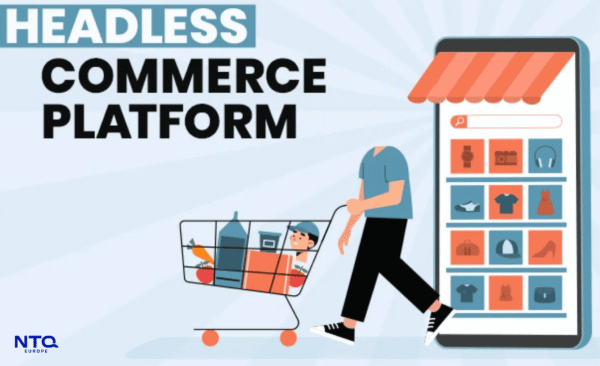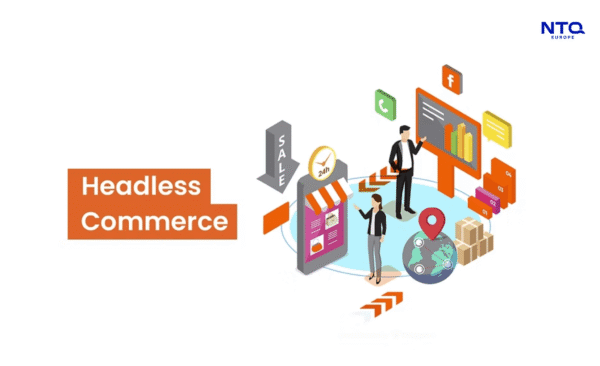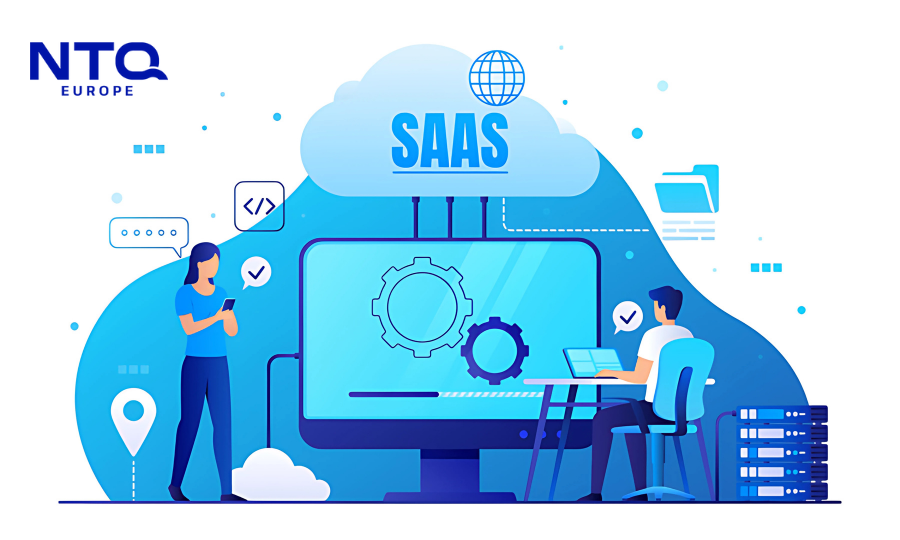1. Introduction to ecommerce development
The rapid evolution of digital commerce has transformed how businesses interact with customers and scale their operations. Ecommerce platforms today are no longer just online catalogs with a checkout page—they are full ecosystems that integrate product information, logistics, personalization, payments, and customer engagement into a unified digital experience.

This shift highlights the importance of modern ecommerce development. It’s not only about building a store—it’s about designing systems that are flexible, scalable, and aligned with rapidly changing user expectations and digital behavior.
As customer touchpoints multiply across web, mobile, marketplaces, and physical channels, traditional ecommerce architectures are showing their limits. This is where headless commerce becomes essential. By decoupling the frontend (what the user sees) from the backend (commerce engine), businesses can innovate and deliver tailored experiences faster, across any channel.
2. Types of ecommerce development models
Before diving into how headless commerce works, let’s briefly explore the four main ecommerce models and why they matter when choosing your architecture.
B2C (business to consumer)
This is the most recognizable model, where companies sell directly to consumers through online storefronts. Speed, design, SEO, and conversion rate optimization are critical. Many B2C brands adopt headless commerce solutions to create visually rich, lightning-fast shopping experiences.
B2B (business to business)
In B2B ecommerce, companies sell to other businesses. This often involves complex pricing models, large order volumes, and integration with procurement systems. Enterprise headless commerce is increasingly being used here to provide custom portals for each client while maintaining a single backend engine.
C2C (consumer to consumer)
Marketplaces like eBay or Vinted are classic examples of C2C ecommerce. The platform facilitates transactions between individuals. These platforms require scalable, modular architecture and highly customizable interfaces—making headless architecture a strong choice for developers.
D2C (direct to consumer)
This model allows brands and manufacturers to skip intermediaries and sell directly to customers. D2C relies heavily on brand identity and unique storytelling. A headless approach gives marketers more freedom to build highly customized, content-rich experiences across different channels. Shopify headless is a popular solution here, combining ease of management with frontend flexibility.
3. Key features of a high-performing ecommerce platform
Whether traditional or headless, an effective ecommerce platform must support a wide range of business and technical needs. Here are the core features that matter most.
Smart product and inventory management
A centralized system should handle multiple product variations, dynamic pricing, warehouse syncing, and supply chain visibility. These backend capabilities remain consistent in headless setups, while the frontend can be built independently to showcase products however you want.
Seamless checkout and secure payment systems
A smooth, fast, and secure checkout experience directly affects conversion rates. The backend should support various payment methods (credit cards, digital wallets, BNPL), tax calculations, and fraud detection. A headless system allows you to optimize and customize the checkout flow on different devices while reusing the same secure infrastructure.
Responsive design and cross-platform experiences
More than 50% of ecommerce traffic now comes from mobile devices. Mobile-first or even mobile-only design is becoming standard. With headless commerce, you can build PWAs, native apps, or adaptive web frontends using frameworks like React or Vue, all powered by the same commerce backend.
Content flexibility through modern CMS
Traditional platforms often combine content and commerce into one rigid system. Headless commerce lets businesses use best-in-class CMS platforms (e.g., Contentful, Storyblok, Sanity) to create, manage, and distribute content independently of the ecommerce engine. This separation is especially useful for marketers running multiple campaigns or content versions.
Omnichannel delivery
Today’s shoppers expect a seamless experience across web, mobile, in-store kiosks, chat apps, and social media platforms. Headless architecture ecommerce makes it possible to serve consistent product data and user experiences across all channels from a single backend.
4. What is headless commerce?
Headless commerce refers to an ecommerce architecture where the frontend presentation layer (what users see and interact with) is completely separated from the backend logic (such as inventory, checkout, payments, and customer data). The two layers communicate via APIs.
This decoupling allows brands to build highly customized and flexible digital experiences without being restricted by the limitations of traditional monolithic ecommerce systems. It enables developers to use any technology they prefer on the frontend—whether it’s React, Vue, Angular, or even native mobile apps—while still leveraging a robust commerce engine in the backend.

For many businesses, headless commerce is a critical step in digital transformation. It gives product, marketing, and tech teams the freedom to innovate, test faster, and adapt quickly to changing user expectations.
5. How headless commerce architecture works
In a headless commerce architecture, the core elements of ecommerce—product catalog, shopping cart, order management, user accounts—live in a centralized backend platform. This backend exposes its functionality via APIs, which frontend applications consume to display data and execute actions.
Here’s how it typically looks in practice:
- A content team uses a headless CMS to manage landing pages and blog content.
- A marketing team builds personalized campaign pages in a frontend framework like Next.js.
- A development team connects the custom frontend to the backend commerce platform (such as Shopify, BigCommerce, or Magento) via APIs.
- The same backend powers multiple interfaces: desktop, mobile, progressive web apps (PWAs), and in-store screens.
This flexible setup is ideal for businesses looking to create seamless omnichannel experiences while keeping backend systems scalable and secure. It also lays the groundwork for composable commerce vs headless ecommerce discussions, where companies may go further by adopting modular services for every layer (PIM, search, CMS, checkout, etc.).
6. Benefits of headless commerce
Adopting a headless approach offers both business and technical advantages. Below are some of the most important:
Speed and agility in development
Because frontend and backend teams can work independently, development cycles become faster. New campaigns, layouts, or site changes can be deployed without waiting on backend updates.
Personalized user experience
Headless commerce allows brands to tailor the frontend for specific user segments. Developers can implement A/B tests, animations, and modern UI components that enhance conversion rates.
Omnichannel readiness
Businesses using headless architecture ecommerce can reuse the same backend for multiple sales channels—desktop web, mobile apps, smart devices, voice assistants—providing a consistent brand experience everywhere.
Better performance and SEO
By leveraging fast frontend technologies and decoupling rendering from backend processing, pages load faster and score higher on Core Web Vitals. This boosts organic traffic and customer engagement.
Future-proof and scalable
Because the frontend is not tied to a specific backend platform, businesses can evolve their tech stack over time—migrating backend components, switching CMS providers, or integrating new tools—without overhauling the entire system.
7. Challenges and trade-offs of headless commerce
While the benefits are significant, adopting a headless model also comes with its own set of challenges:
Increased complexity
Managing multiple services, deployments, and API integrations requires experienced development teams and a strong DevOps pipeline. This is especially important for enterprise headless commerce implementations.
Higher initial cost
Compared to turnkey ecommerce platforms, headless systems typically have higher upfront costs for development, hosting, and third-party services. However, these costs often pay off in the long term via improved performance and flexibility.
Ongoing maintenance
Maintaining separate frontend and backend environments means increased QA requirements, release management, and documentation. Businesses need to plan for this operational overhead.
That’s why companies must carefully evaluate their goals, team capabilities, and long-term strategy before transitioning to headless commerce solutions.
8. Headless commerce examples
Several leading global brands have adopted headless commerce to deliver next-level customer experiences and streamline operations. Let’s explore some real-world applications.
-
Nike
Nike shifted to a headless setup using React and Node.js for its frontend, connected to a custom backend. This allowed their team to build high-performance mobile experiences and optimize content delivery in real time across regions. Their transition is a textbook example of enterprise headless commerce done right.
-
Sephora
Sephora leveraged a headless CMS and ecommerce stack to offer personalized content, fast mobile experiences, and seamless integration with loyalty programs and in-store tech. This headless approach enabled them to support omnichannel campaigns and in-app beauty tutorials.
-
Venus
The fashion brand Venus adopted a headless commerce architecture to modernize their digital storefront. This allowed marketing teams to build campaign-specific landing pages faster and independently, resulting in increased conversions.
These headless commerce examples demonstrate how flexibility, speed, and personalization at scale are critical for competitive advantage.

9. Headless vs traditional vs composable commerce
Traditional ecommerce
In traditional platforms like Magento (in its monolithic form) or older versions of WooCommerce, the frontend and backend are tightly coupled. This makes it difficult to change the design or launch new experiences without affecting the entire system.
Headless commerce
As we’ve discussed, headless commerce architecture separates concerns—frontend and backend evolve independently. This provides flexibility but requires more technical maturity.
Composable commerce
Often confused with headless, composable commerce takes the concept further. It’s not just separating frontend from backend—it’s about assembling your tech stack from best-of-breed services: one for CMS, another for search, another for checkout, and so on.
Composable commerce vs headless ecommerce is not an either/or choice—headless is often a stepping stone to composable architecture.
10. What to consider before going headless
Before investing in a headless commerce platform, businesses should assess their:
- Technical team readiness
- Budget for development and integrations
- Need for content flexibility and customization
- Growth plans (e.g. multi-storefront, multi-language, or multi-region)
- Ability to manage multiple third-party services
Headless isn’t for every business. For some, a hybrid or traditional model may suffice. But for ambitious brands aiming for long-term digital scalability, headless architecture is the modern foundation.
11. Choosing the right headless commerce partner
Implementing headless commerce requires deep expertise in system integration, UX/UI, cloud infrastructure, and agile delivery. Choosing the right partner can make or break the success of your digital transformation.
An ideal headless commerce development company should:
- Understand your industry and user behavior
- Provide end-to-end services from strategy to post-launch support
- Be skilled in both enterprise headless commerce and modern frontend frameworks
- Support integration with your existing tools like ERP, CRM, CMS, and payment gateways
- Offer scalability for global rollout
At NTQ Europe, we combine technical excellence with business acumen to deliver scalable, user-centric headless commerce solutions. From building composable architectures to launching mobile-first storefronts, we help you stay ahead of the digital curve.



















